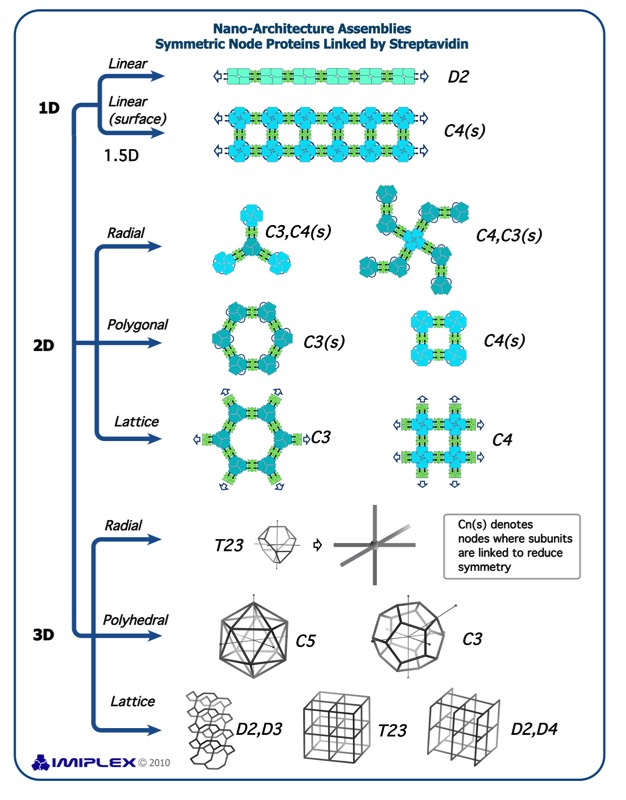Technology Architecture
A practical platform for protein-based nanotechnology can be based on the development of a modular set of nanostructure building blocks that enable construction of highly customizable architectures. The nanostructures are assembled from “struts”, that are basically linear structural elements, and “nodes”, that have plane or point group symmetry. Components are designed to incorporate features so that nanostructures assembled from struts and nodes can be additionally functionalized through attachment of other proteins (e.g. antibodies, protein and peptide binding domains, growth factors) to create a great variety of precision nanostructures with biomedical research or practical applications such as biomaterials, biosensors or diagnostic devices.
Nano-Architecture using Proteins
Struts are based on streptavidin, a 60K MW D2-symmetric tetramer that binds 4 biotin cofactors with very high affinity (Kd=10-14), in orientations approximating the legs of an “H”. Nodes are engineered protein multimers with Cn, Dn, or higher symmetry that have been chemically modified to incorporate covalently bound biotin groups that are pairwise complementary to biotin binding sites on streptavidin.
A practical platform for protein-based nanotechnology can be based on the development of a modular set of nanostructure building blocks that enable construction of highly customizable architectures. The nanostructures are assembled from “struts”, that are basically linear structural elements, and “nodes”, that have plane or point group symmetry. Components are designed to incorporate features so that nanostructures assembled from struts and nodes can be additionally functionalized through attachment of other proteins (e.g. antibodies, protein and peptide binding domains, growth factors) to create a great variety of precision nanostructures with biomedical research or practical applications such as biomaterials, biosensors or diagnostic devices.
Nano-Architecture using Proteins
Struts are based on streptavidin, a 60K MW D2-symmetric tetramer that binds 4 biotin cofactors with very high affinity (Kd=10-14), in orientations approximating the legs of an “H”. Nodes are engineered protein multimers with Cn, Dn, or higher symmetry that have been chemically modified to incorporate covalently bound biotin groups that are pairwise complementary to biotin binding sites on streptavidin.

A variety of one, two, and three-dimensional architectures can potentially be assembled using a relatively small set of molecular components. Nature has provided a large number of nodes with both plane group symmetry suitable for construction of 2-dimensional structures and polyhedra, as well as nodes with Dn or higher symmetry suitable for assembling 3-dimensional structures.
The underlying structural architecture has been designed to incorporate chemical, optical, or biological function either through chemical modification or through covalent incorporation of protein structural motifs using recombinant DNA technology.
The underlying structural architecture has been designed to incorporate chemical, optical, or biological function either through chemical modification or through covalent incorporation of protein structural motifs using recombinant DNA technology.